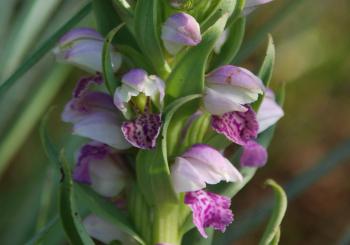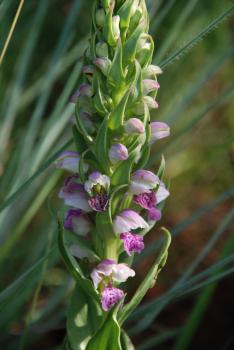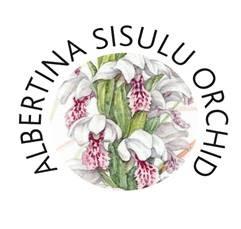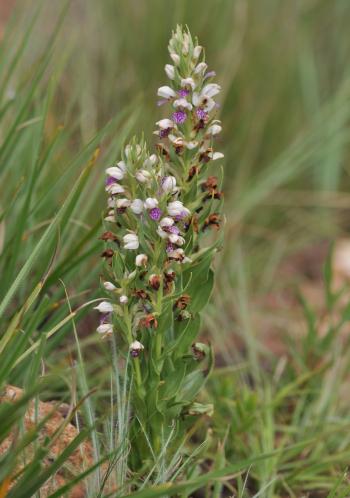Brachycorythis conica subsp. transvaalensis
Brachycorythis conica (Summerh.) Summerh. subsp. transvaalensis Summerh.
Family: Orchidaceae
Common names: Albertina Sisulu Orchid
Introduction
This beautiful and enigmatic orchid was first recorded in 1918; it was last seen in the Gauteng Province in 1956, until its rediscovery in 2007. This species was historically known from several locations, mostly in the Gauteng Province, however, all indications are that it has now been largely lost to rapid urbanization, and only remains as a viable colony at one location.

Description
Description
This perennial grassland orchid stands about 300 to 400 mm high when in flower during the latter part of summer on the Highveld. The shiny, bright green, triangular leaves are short and broad, tapering to a pointed tip and are arranged spirally all the way up the stem where they become progressively smaller towards the inflorescence. Among the inflorescence, the leaves are reduced to pointed narrow bracts amongst the flowers. The sweetly scented flowers are produced in late summer and are arranged in a spike on the upper part of the plant. Individual flowers are white with a pale to dark pink or mauve lip (modified petal). The lip is also variously spotted and marked with darker pink to mauve markings.

Conservation Status
Status
This orchid is very rare and currently only known from one viable population in western Gauteng. The species is listed as Critically Endangered (CR) on the Red List of South African plants. The Mogale City Local Municipality (in whose region the land falls), had originally proposed the greater area as an Urban Biodiversity Reserve, as the entire ecosystem in which the orchid occurs is listed as a Critically Endangered Eco-system; however, the Municipality has subsequently abandoned these plans in favour of using the land for developing housing projects. A local community group has challenged the approval to allow housing on such a sensitive environment; they are currently requesting the Gauteng High Court to review this decision, as they would prefer to see the original plan of establishing a reserve implemented.

The Wild Orchids of South Africa (WOSA) <https://wildorchids.co.za/html/> and Proteadal Conservation Association (PCA) <http://proteadalconservation.co.za/> created a logo for the Albertina Sisulu Orchid in 2016, which they could use to associate with conservation efforts to conserve this orchid. The logo was designed by Moira von Winkel using a 2015 watercolour painting of the species by Daleen Roodt, who is an acclaimed watercolour botanical and nature artist.
Distribution and habitat
Distribution description
Years ago this orchid was apparently more common around Gauteng where it was recorded from isolated records ranging from Pretoria to Heidelberg with a few outlying records in Mpumalanga and Limpopo Provinces. It occurs in rocky and wooded grassland mostly on ridges.

Derivation of name and historical aspects
History
The name Brachycorythis, is derived from the Greek word brachys, which means ‘short’ and korys, korythos, which means ‘helmet’, referring to the cucullate labellum (cucculate means cup-shaped, and a labellum (or lip) is a modified petal found in all orchids).
The species name conica, means ‘cone-shaped’, in reference to the shape of the nectar-producing spur, which is located at the base of the flower.
The subspecies name transvaalensis, meaning of the Transvaal, is in reference to the old Transvaal Province of South Africa prior to 1994, to which the species is endemic, i.e. it occurs nowhere else in the world.
This species was initially misidentified as Brachycorythis tenuior, a close relative, and illustrated as such in Flowering Plants of Africa in 1933, until it was later realised that it was in fact a separate species; which was then (1955) named as a new species by the Kew botanist and orchid scientist, Victor Samuel Summerhays (1897–1974).
The genus Brachycorythis is comprised 36 species and is distributed mostly in Africa with 24 species; a further 12 species occur in Asia. In southern Africa there are seven species, six of which are in found in the eastern Provinces from the Eastern Cape to Limpopo, with one species occurring in the southern Cape. Of the seven South African species, only this species (Brachycorythis conica subsp. transvaalensis) is threatened with extinction.
This species was overlooked by botanical scientists and conservationists for many years. Since 1956, no records of this species were recorded in the Pretoria National Herbarium, until 2007, when the population in western Gauteng was rediscovered quite by accident. Since then much research work has been done to establish the conservation status of the species. So far only the western Gauteng population remains to be a viable option for conservation, although threats of urbanization and habitat destruction still persist.

This species has until now had no recorded common names, as a result the name Albertina Sisulu Orchid has been given, in commemoration of the wife of the apartheid stalwart, Walter Sisulu. Albertina Sisulu (aka Ma Sisulu, (1918–2011), was an anti-apartheid activist born in Transkei in 1918, the same year the orchid was first discovered. In 1955, Ma Sisulu joined the ANC Womens League and took part in the launch of the Freedom Charter, the same year the orchid was named by the Kew botanist and orchid scientist, V.S. Summerheyes. In 1956, Ma Sisulu joined Helen Joseph and Sophia Williams-De Bruyn, in a march of 20 000 women against the apartheid pass laws to the Union Buildings in Pretoria, the same year the orchid was last seen in Gauteng, until its rediscovery in 2007 by a horticulturist working at the Walter Sisulu National Botanical Gardens.
Ecology
Ecology
Due to the long history of a lack of research into this species, very little is published about the ecology or biology of the species. Many orchids have a specific pollination regime in order to prevent inbreeding or self-pollination. Recent preliminary studies by Prof. Craig Peter from Rhodes University in Grahamstown, have identified the most likely pollinator to be a solitary Anegilla bee species (family: Apidae), however, a large wasp (family: Eumenidae) was also observed bearing pollinaria (C. Peter pers. comm.), which may also prove to be the pollinator.
Most terrestrial orchids are dependent on one or more species of root fungus (mycorrhiza) to germinate the seed, and grow with the orchid in a symbiotic relationship. It is thought that this relationship may be required for the survival of some of the terrestrial orchid species. Many species of orchids have a unique species of fungus (possibly more than one), which is associated with each species of orchid. Nothing is known about the mycorrhizal relationships in this species and collaborative research into this subject is ongoing.
This species occurs in a fire climax grassland habitat, as such it has the ability to remain underground in a dormant state for the dry winter months when the chances of fire are highest. It resprouts from small finger-like tubers in spring when the wet season begins. Flowering takes place in late summer.

Uses
Use
Orchids from this genus and other genera (Disa, Satyrium, Habenaria), are apparently used in Zambia and Malawi for making chikanda or ‘African polony’ from the edible tubers. There are no other recorded or published uses for this plant, possibly due to its rarity.
Growing Brachycorythis conica subsp. transvaalensis
Grow
Unfortunately there are no records of this species ever being successfully cultivated. This is not uncommon with many South African terrestrial (growing in the ground) orchids. Probably in a large part due to the orchid’s dependence on symbiotic relationships with mycorrhiza (root fungus), which live in the soil where the orchid occurs. Even when terrestrial orchids are transplanted with their own habitat soil, the plants invariably die either immediately or after a couple of years. The plants have small tubers from which they resprout annually. These tubers are usually very soft and delicate; the smallest amount of damage to the tubers invariably leads to the tubers rotting. Research into the cultivation of terrestrial orchids is ongoing and some recent success has been achieved with certain other species. All orchids are also protected by law in South Africa and digging any plants out of the wild is illegal, without a permit. Most terrestrial orchids are very sensitive and plants that are dug out invariably die.
Cultivation of terrestrial orchids from seed is equally complex. The seed must either be grown in the presence of the correct mycorrhizal fungus, or more commonly need to be germinated in flasks under laboratory conditions. Until now no success has been achieved by experts trying to cultivate this species from seed. However, research is ongoing and hopefully in the future the species may be seen in cultivation. The protection of this orchid in its natural habitat is therefore of paramount importance for the survival of the species
References
- Archibald, R. & Henderson, C. 2011. Feasibility Report: Urban Biodiversity Reserve. South African National Biodiversity Institute. WSP Unpublished Draft report. Report No. 2167ES/3/Draft.
- Compaan, P. (compiler). 2011. Gauteng Conservation Plan version 3.3. Gauteng Department of Agriculture and Rural Development: Nature Conservation Directorate.
- Hankey, A. 2013. Brachycorythis conica subsp. transvaalensis, in D. Raimondo, Plants in peril. South African National Biodiversity Institute (SANBI), Pretoria, South Africa.
- Hankey, A.J. & De Castro, A. 2014. The most threatened plant in Gauteng: Brachycorythis conica subsp. transvaalensis (Orchidaceae), South Africa. Poster presentation, 21st World Orchid Conference, Sandton Convention Centre, South Africa.
- Johnson, S. & Bytebier, B. 2015. Orchids of South Africa: a field guide. Penguin Random House South Africa.
- McMurtry, D., Grobler, L., Grobler, J. & Burns, S. 2008. Field guide to the Orchids of northern South Africa and Swaziland. Umdaus Press, Pretoria.
- National Environmental Management: Biodiversity Act: National list of ecosystems that are threatened and in need of protection, (G 34809, GoN 1002), 9 December 2011.
- Quattrocchi, Umberto. 2000. CRC World Dictionary of plant names, common names, scientific names, eponyms, synonyms and etymology. Volume IV R-Z, CRC Press, Florida, USA.
- Summerhayes, V.S. 1955. A revision of the genus Brachycorythis. Kew Bulletin 10: 244,245.
- Von Staden, L., Hankey, A.J., Mills, L. & Raimondo, D. 2015. Brachycorythis conica (Summerh.) Summerh. subsp. transvaalensis Summerh. National Assessment: Red List of South African plants version 2015.1. Accessed on 2016/01/22.
- Wodrich, K. & Hankey, A.J. 2014. In Situ Conservation Plan for Brachycorythis conica subsp. transvaalensis: WOSA & SANBI, internal document.
- Wikipedia: https://en.wikipedia.org/wiki/Albertina_Sisulu (Accessed on 2016/01/23).
Credits
Andrew Hankey
Walter Sisulu National Botanical Garden
March 2016
Plant Attributes:
Plant Type: Orchid
SA Distribution: Gauteng, Limpopo, Mpumalanga
Soil type: Loam
Flowering season: Late Summer
PH: Neutral
Flower colour: White, Mauve/Lilac
Aspect: Full Sun
Gardening skill: Challenging
Special Features:
Horticultural zones







Rate this article
Article well written and informative
Rate this plant
Is this an interesting plant?
Login to add your Comment
Back to topNot registered yet? Click here to register.